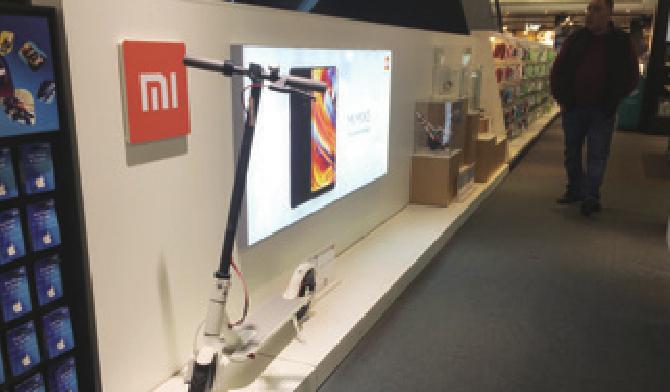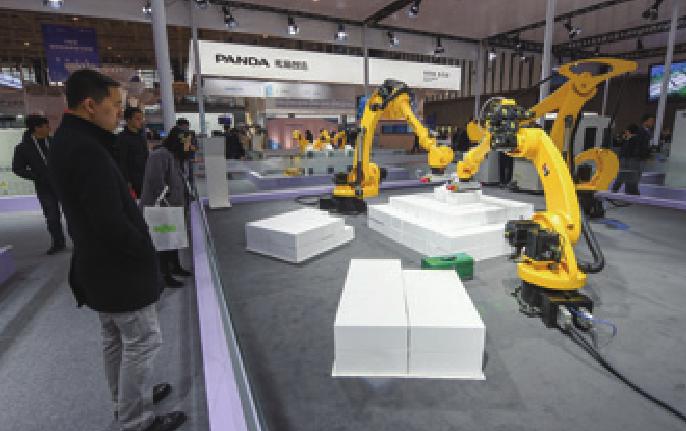From Competition To Coopetition
2019-02-14ByLiXiaoyang
By Li Xiaoyang


As the world counted down the arrival of 2019, many Chinese business community insiders remembered the famous bet that was about to come to fruition. The story went back to 2013, when at an awards ceremony, Lei Jun, CEO of smartphone manufacturer Xiaomi, proposed a 1-yuan($0.15) bet that his companys revenue in 2018 would top leading home appliance maker Gree Electric. Not to be outdone, Grees Chairperson Dong Mingzhu upped the ante to an extravagant 1 billion yuan ($147 million).
After five years, the wager has an initial outcome. Though Grees gross corporate revenue was over 10 billion yuan ($1.47 billion) ahead of Xiaomis by September 2018, Xiaomi didnt really lose in terms of its growth amid the changing economic landscape where the real economy is further integrating with the Internet.
While recently announcing the victory to the media, Dong also stressed that it was actually meaningless to compare the two companies. It was like making the apple-andorange comparison, since Gree focuses on manufacturing, while Internet-based Xiaomi essentially falls under asset-light enterprises, which provide added value in areas such as product design, marketing and supply chain orchestration.
As the largest air conditioner manufacturer in the world, Gree has developed a complete industrial chain strongly backed by technological research and development. With physical stores across the country, the company has effectively retained customers through its sophisticated after-sales services.
Xiaomi, on the other hand, mainly conducts its sales through online platforms, attaching less importance to brick-andmortar stores. When making the wager with Dong, Lei said the model helps save distribution channel costs and allows Xiaomi to focus on research and development and user experience.
Brought together by the wager, Gree and Xiaomi have both witnessed notable growth in the past fi ve years. In addition, changes in Chinas economic landscape with the rapid integration of online and offline operations have driven the companies to experiment with each others business models. As Gree expands its business to new-energy vehicles, memory chips and phones, Xiaomi has also tapped into the smart home appliance industry by cooperating with traditional manufacturing enterprises.
Common boom
Although Xiaomi failed to notch up a higher turnover than Gree when the wager concluded, both companies have won the game in a sense, especially Xiaomi, which has seen remarkable development, Liu Buchen, a senior home appliance industry analyst, said.
In 2013, Xiaomis revenue was only about 25 percent of Grees. Yet the figure reached 87.76 percent in the third quarter of 2018. Xiaomis gross revenue soared by nearly fi ve times from about 26.5 billion yuan($3.9 billion) in 2013 to 130.4 billion yuan($19.2 billion) in the third quarter of 2018, according to its fi nancial report.
The company has also performed well in the global market. According to data released by global market information provider International Data Corp., Xiaomi accounted for 9.7 percent of global smartphone shipments in the third quarter of 2018, ranking fourth worldwide. Its shares began trading on the Hong Kong Stock Exchange on July 9, 2018, and exceeded Gree in terms of market value, achieving neck-and-neck growth with the air conditioner giant.
With its business expanding beyond smartphones to hi-tech devices, Xiaomi made 10.8 billion yuan ($1.5 billion) in extra revenue through the Internet of Things (IoT) and lifestyle segment, and beat Apple as the shipment of its wearable devices reached 6.9 million units in the same period.
Still, Xiaomis profi t-making performance was weaker compared to Grees in the first three quarters of 2018. In that period, Xiaomis net profi t was only 6.7 billion yuan($0.9 billion), while that of Gree reached 21.1 billion yuan ($3.1 billion). Starting from a higher base, Gree achieved sales revenue of 148.6 billion yuan ($21.9 billion) in the third quarter of 2018. It has topped Chinas air conditioner market since 2012 and taken the lions share in the global residential air conditioner market, making Xiaomis catching up with it no easy task.
In the fi ve-year race, the two companies have attempted to gain an edge through reaching out to the core businesses of the other. Xiaomi has been making Internetbased air conditioners by cooperating with Midea, another leading Chinese home appliance brand. Gree has also developed its own phones connected in real time with its smart home appliances. While neither product has made prominent contributions to sales so far, the moves mark a start as the two companies continue to break the ceiling.
Ongoing integration
Despite prominent achievements in the past fi ve years, both Gree and Xiaomi are fi nding themselves constrained by bottlenecks. Data from the China Academy of Information and Communications Technology showed that the shipment of smartphones in the Chinese market from January to November 2018 stood at 379 million units, down 15.6 percent year on year.

Although Xiaomi smartphones have performed well in markets in the rest of the world, its shipments saw a decline of 16 percent in the Chinese market in the third quarter of 2018 year on year, according to a report by Counterpoint Research, a global industry analysis company.
The Chinese smartphone market is consolidating around the leading brands and the competition to occupy the high-end market remains fierce as consumers grow more demanding. Smartphones without technological innovation may not be attractive enough to spark new buying trends, Sun Wenping, President of the Shenzhen Mobile Communications Association, said.
According to Mo Jia, an analyst with Canalys, a marketing, analytics and research firm, Xiaomi needs to make more efforts to change its brand image, gearing toward high-end products. Currently, low-price smartphones account for the majority of Xiaomis shipments.
To blaze a new trail, Xiaomi has begun to promote offline stores and improve its input in research and development. It plans to invest over 10 billion yuan in artifi cial intelligence and IoT in the next fi ve years, Lei announced on January 11. In late December 2018, the company entered into cooperation with TV and consumer electronics giant TCL to utilize the latters advantages in terms of supply chains and manufacturing.
As for Gree, 85 percent of its revenue comes from the air conditioner market, which has shown initial signs of decline due to a drop in demand. According to official data, the number of air conditioners sold in China in July 2018 was 9.88 million units, down 5.1 percent year on year. Consequently, Gree, once only focusing on home appliances, has also shifted toward smart manufacturing by utilizing the business models of Internet-based companies.
However, Dong champions the significant role of the real economy and opposes talking down traditional industries. “Im not downgrading the Internet-based industries but just believe that they need the support of the real economy to achieve real perfection,” she said recently. Viewing the current economic landscape in China, it seems that Dongs remarks have been partially proven right by the mounting coopetition—competition in some aspects and cooperation in others—of traditional and Internet industries.
According to a white paper on Chinas Internet-based economy released on January 11, the country is witnessing further integration of the Internet and the real economy. The report suggests consumeroriented online businesses gradually shift toward the industrial Internet to enhance the efficiency of production. Traditional industries are advised to seek upgrading through technologies and Internet-based marketing practices to further tap niche markets.
Michael Zakkour, Vice President of China/Asia Pacific Strategy and Global Digital Practices at consulting fi rm Tompkins International, said IoT is making modern life smarter and changes in traditional business models necessary. “We are in the New Retail and digital transformation era in China. Companies must rethink their makeit, move-it and sell-it strategies, tactics and partnerships,” he told Beijing Review.
